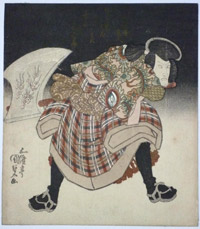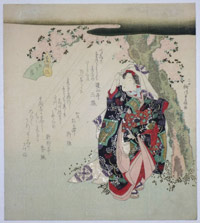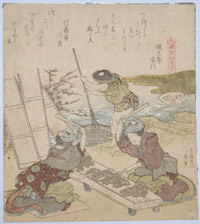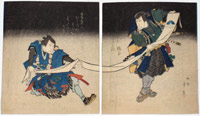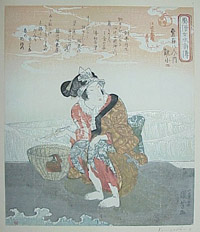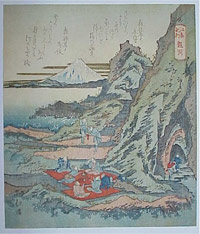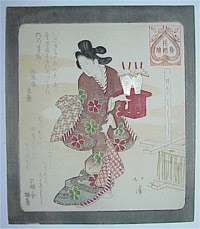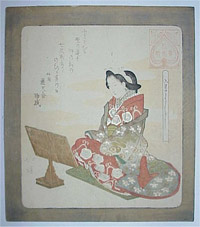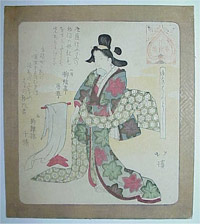/category/surimono/page/3/
Ryuryukyo SHINSAI (1764 ?-1820)
Click here to view image full size.
A rare surimono showing a red bream, sea urchin, cuttle-fish, various other molluscs and two unidentified fish with seaweed. Issued c 1810s.
Fine impression with gauffrage. Fine colour and very good condition. Signed Shinsai.
Status: Sold
Katsushika HOKUSAI (1760-1849)
Click here to view image full size.
A fine long surimono with poems attached showing horsetails, fern fronds and kuzu ( arrowroot ) lying in and around a lady’s travelling hat with silk cushion and the two red cords for tying. Of the utmost rarity: other impressions in TNMC, no. 3708 ( without poems ? ); Matthi Forrer, Hokusai, no. 67, p. 64 ( with poems ); Surimono: Prints by Elbow, Edythe Polster and Alfred Marks, 1979, Lovejoy Press, F-D 1933-4-2680, p. 267, ( without poems ? ). But miscatalogued as a bowl with green vine and plants. Ex Hayashi; and evidently an impression in the Ota Memorial Museum of Art, Jingumae, Tokyo. There is also a Hokusai square surimono of the same subject illustrated in The Art of Surimono, Roger Keyes, 198, p. 226. Issued 1801. A beautiful print.
Fine impression. Very good colour. Minor marks. The inevitable folds hardly discernable: These surimono were folded three times, once horizontally and twice vertically to form a neat packet. The facing text ( announcement or poems ) were an irritation to many early collectors and were trimmed off, making this example even rarer. Otherwise very good condition. Signed Gakojin Hokusai utsushi.
Status: Sold
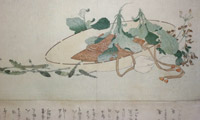
Click here to view image full size.
Teisai HOKUBA (1771-1844)
Click here to view image full size.
Three courtesans watching clients leaving in light rain. One of Hokusai’s best pupils; a fine painter and illustrator of kyoka books.
Very good impression, colour and condition. Signed Hokuba ga.
Status: Sold
Utagawa KUNISADA (1786-1865)
Click here to view image full size.
The actor Bando Mitsugoro III as Washi no Osaburo disguised as Yamagatsu Kumao in Kawaranu hana Genji no kaomise performed at the Ichikawa Theatre in 11/1827. The left sheet of a surimono triptych probably issued for the new year of 1828. The complete set is in the Victoria and Albert Museum, London ( E.3909-1916 ). A variant of the Kabujki play Seki no to in which two actors battle with giant axes.
Fine impression with gold and silver. Slight fading, otherwise very good condition. Signed Gototei Kunisada ga.
Status: Sold
Utagawa KUNISADA (1786-1864)
Click here to view image full size.
A fine surimono showing the actor Danjuro VII casting roasted beans from a tray he holds in his left hand. This ritual called setsubun, “end of winter” was performed in the precincts of temples in the Spring (although now takes place in February). He wears the well known Shibaraku costume with the large mimasu crests. Two poems above by Shiseido Sutena and Hoichitei Masunari. The latter being a member of the Taiko-ren, Drum poetry club. Their symbol top right corner. Issued c 1822. Illustrated in colour on the front cover of Art of the Surimono, Theodore Bowie, Indiana University Art Museum, 1979. Rare.
Superb impression with extensive gold and silver. Perfect colour. Light Japanese backing and slightly trimmed at left. Signed Gototei Kunisada ga.
Status: Sold
Yanagawa SHIGENOBU II (Active 1824 – 1860)
Click here to view image full size.
San konoshitakage, “Number Three: In the Shade of a Tree” from a set: Meiba zoroe, “Famous Horses.” Shows a beauty sheltering from rain. Published for the Horse Year 1834.
Fine impression. Very good colour and condition. Signed Nisei Yanagawa Shigenobu
Status: Sold
Katsushika HOKUSAI (1760 – 1849)
Click here to view image full size.
Kinutagai, “The Fulling Block Shell” from the series: Genroku Kasen kaiawase, “A Matching Game with the Genroku Poem Shells.” ( An anthology published in 1689. ) A collection of verses with pictures designed by Hokusai printed on 36 sheets. Commissioned by the Yomogawa poetry group for the New Year 1821, Year of the Snake. Shows two women at a fulling block beating down scrap paper to pulp to remake into sheets. In the background a boy is stirring the pulp in a basket in a stream. One of the two best known Hokusai surimono sets. Rare.
Fine impression, very good colour with gold and silver. Minor marks and signs of mounting au verso, otherwise very good condition. Signed Getchirojin I itsu hitsu, “Moonstruck Old Man, Iitsu.”
Status: Sold
Katsushika HOKUSAI (1760 – 1849)
Click here to view image full size.
Sakuragai, “The Cherry Blossom Shell” from the series: Genroku Kasen kaiawase, “A Matching Game with the Genroku Poem Shells.” ( An anthology published in 1689. ) A collection of verses with pictures designed by Hokusai printed on 36 sheets. Commissioned by the Yomogawa poetry group for the New Year 1821, Year of the Snake. Shows travellers on the way to Narita Fudo, the Shinshoji at Naritasan. One of the two best known Hokusai surimono sets. Rare.
Fine impression and colour with gold and silver. Minor marks, otherwise fine condition. Signed Getchirojin I itsu hitsu, “Moonstruck Old Man, Iitsu.”
Status: Sold
Katsushika HOKUTAI (Act. c. 1800 – 1830)
Click here to view image full size.
A long surimono by an early pupil of Hokusai. Most likely an invitation to a New Year musical event at Shinagawa ( ? ). Shows three musicians playing samisen, koto and kokyu ( ? ). Probably a unique impression. An Eisai Hokutai was the artist for a book: Tokaeri-bana in 1809. This appears to be the same artist.
Fine impression with gauffrage. Fine colour. Signs, as usual, of the foldmarks on the invitation: These invites were folded three times – once horizontally and twice vertically to form a neat packet. Otherwise very good condition. Signed Shinshinshi Hokutai.
Status: Sold
Utagawa KUNISADA (1786 – 1865)
Click here to view image full size.
Ichikawa Danjuro VII as Urashima Taro, seated with his fishing rod and the black box behind him that contains his old age. Urashima Taro saved a giant tortoise and was rewarded by a visit to the Dragon King’s palace beneath the sea by the Dragon’s daughter Otohime. Published for the Taiko-gawa poetry group ( red drum seal top right ) in 1820.
Very fine impression and colour with gold and silver. Fine condition. Signed Gototei Kunisada ga.
Status: Sold
Utagawa KUNISADA (1786 – 1865)
Click here to view image full size.
Ichikawa Danjuro VII ( crouching below ) as Konoshita Tokichi and Segawa Kikunojo V as Princess Otohime. This does not illustrate a particular play, but was obviously intended for the year 1820 as Otohime was the daughter of the Dragon King ( 1820 being a dragon year ).
Fine impression. Very good colour. Extensive gold and silver. Fine condition. Signed Gototei Kunisada ga.
Status: Sold
Utagawa KUNISADA (1786 – 1865)
Click here to view image full size.
Two sheets ( of three ) showing the actor Ichikawa Danjuro VII ( left ) in the role of Minamoto Yorimasa holding a firebrand to better see the giant Nue and Bando Mitsugoro III as Tametomo with his giant bow. The complete set is in the Fitzwilliam Museum, Cambridge. It appears to be a mitate as these three actors did not act together. The dragon-patterned border indicates the dragon year 1820. The bright blue grounds make for striking compositions.
Very fine impressions. Some slight loss of metallic powders, otherwise very good condition. Signed Kunisada ga on each.
Status: Sold

Click here to view image full size.
Shibata ZESHIN (1807 – 1891), Ikeda TAISHIN and SUISHIN
Click here to view image full size.
A complete set of the four seasons in shijo style: Spring showing cherry blossom viewing signed Taishin; Summer is a still life of theatre props signed Zeshin; Autumn shows people moon viewing signed Suishin, and Winter shows a woman tentatively lifting a bamboo screen on a snow-bound boat signed Zeshin. Extremely rare: This is the only set I have recorded and came from me in the 1980s. The prints were originally folded and would have been sold in paper slip cases ( hence the slight vertical folds ). Although not strictly surimono, they probably served a similar purpose. Each 6.5 x 5.75 inches, 16.5 x 14.5 cms. Taishin and Suishin were pupils of Zeshin and the former was a life long friend of his until his death.
Very good impressions, colour and condition. Signed Zeshin, Taishin and Suishin.
Status: Sold
Utagawa TOYOKUNI I (1769 – 1825)
Click here to view image full size.
A wonderful design showing the actor Ichikawa Ebizo VI ( Danjuro VIII ) holding a large umbrella with his face reflected in a mirror held by an acolyte. Two poems above by Sakuragawa Jihinari and Jihinari’s son Oya no Omokage. In fact these two writers also composed poems for two other Toyokuni surimono of Danjuro around the same date, c. early 1820s. ( See The Art of Surimono, Roger Keyes, 1985, no. 348, p. 400 and One Hundred Surimono in the collection of Sidney C. Ward, 1976, no. 50, p. 62. ) Extremely rare.
Fine impression. Minor creasing and turning of purple, otherwise very good colour and condition. Signed Toyokuni ga.
Status: Sold
Harunobu GAKUTEI (c.1786 – 1868)
Click here to view image full size.
A sumptuously clothed beauty designed for the Shippo Club. The surimono is unusual in having a caramel-coloured background.
Fine impression, colour and condition. Signed Gakutei with seal Shima.
Status: Sold
Kubo SHUNMAN (1757 – 1820)
Click here to view image full size.
A superb surimono showing a group of five cranes on a split of sand. The tancho ( “red crest” ) Japanese Crane, Grus japonensis, is the second rarest crane in the world, migrating to East Asia in the fall to spend the winter. There is also a resident flock in Hokkaido. Much loved by the Japanese, the crane was a symbol of luck, longevity and fidelity.One of a set of six surimono with title: San hira no uchi, “Three Petals” written on a poem slip hanging from a plum branch, top left. Probably Shunman’s masterpiece in this format and one of the handful of great surimono. Exceptionally rare: I have not seen another for sale since I started dealing over 40 years ago and this may well be the only available impression extant. An example is in the Chester Beatty Library, Dublin. See The Art of Surimono, Roger Keyes, Sothebys, 1985, no. 318, p. 363 and colour, p. 344. Another is in the Tokyo National Museum, catalogue II, no. 1654. There are two states with the last character of poem changed. ( For an example of this other state see Surimono, Charlotte van Rappard-Boon, no. 16, p. 33. ) Issued 1816. Shunman, a man of great sophistication, designed only a few prints before concentrating on surimono and printing and issuing some of the finest in this format. ( See The Japanese Print A New Approach, J. Hillier, pp. 102 – 104: “Probably no artist except Choki has achieved so high a reputation on such a small number of prints.” ) He also excelled at painting, book illustration and light verse.
Very fine impression with the feathers of the cranes deeply gauffraged. Fine colour with gold and silver. Minor marks and creases. Seal Shunman lower right corner.
Status: Sold
Katsushika HOKUSAI (1760 – 1849)
Click here to view image full size.
A rare surimono from a series Soramitsuyaren wakan buyu awase samban no uchi, “Japanese and Chinese Heroes for the Soramitsuya Circle.” ( A club named after its leader Soramitsuya Maeda. ) Shows Benkei in a tug-of-war with a Chinese beauty ( possibly Kosanjo according to Keyes ). Poems by Maeda, Magara and Komichi. Published 1820. Two other impressions illustrated in the Spencer Museum of Art, Surimono, Roger Keyes, Kodansha, 1984, no. 26, p. 74 ( catalogue no 110 ) and the Peter Morse collection catalogue, Ota Memorial Museum of Art, 1988, no. 184.
Fine impression, colour and condition. Extensive gold and silver. Signed Hokusai Taito aratame Katsushika Iitsu hitsu.
Status: Sold
Totoya HOKKEI (1780 – 1850)
Click here to view image full size.
The Dragon King, Ryu-jin, presenting the tide-ruling jewels Nanjiu and Kanjiu. In Japanese folklore he ruled the sea and inhabited a spectacular castle in the depths of the ocean.
Fine impression and colour with extensive gold and silver. Minimal edge soil. Signed Hokkei.
Status: Sold
Katsushika HOKUSAI (1760 – 1849)
Click here to view image full size.
A rare surimono from the series Umazukushi, “A Series of Horses” published 1822 ( Year of the Horse ). Shows the banks of the Sumida river, Komatomeishi, with the stone used for tethering horses bottom centre. This surimono is one of three that form a triptych. The complete set is in the Rijksmuseum, Amsterdam ( 1958: 293-294-295 ) and is illustrated in Matthi Forrer, Hokusai, Rizzoli, 1988, no. 265, p. 238 and elsewhere. The other two surimono were also in the Gerhard Schack collection, illustrated in Surimono, 1970, 77-78. Ex collection H. de Winiwater ( seal top right ).
Fine impression with gold and silver. Some soil and loss of the gold. Signed Fusenkyo Iitsu no fude.
Status: Sold
Wakai RYOUNTEI (Dates unknown)
Click here to view image full size.
Shows a dancing shojo: A mythical creature with long red hair who lived near the sea and had an unquenchable thirst for sake. Published c.late 1820s. Rare: Another impression illustrated in One Hundred Surimono in the Collection of Sidney C. Ward, no.95, p.115.
Very fine impression with solid gold ground, other areas printed in gold and silver. Slight loss of gold ground, otherwise very good condition. Signed Morimaru aratame ( “changing his name to” ) Ryountei Wakai. A poet of the Tsubogawa ( the Asakusagawa ) Ren in Asakusa, Edo.
Status: Sold
Katsushika HOKUSAI (1760 – 1849)
Click here to view image full size.
A rare long surimono complete with the attached invitation ( yokonagaban ). Mitate junidan soshi, “A Parody from Twelve Fairy Tales.” Shows Ushiwaka and prince Joruri. The invitation is to a dramatic recital with music ( joruri ) organised by Tokiwazu moji kiyo and has the names of the performers: Tokiwazu Komoji dayu; Kishizawa Koshikibu and others from the Kishizawa school. Another example ( lacking invitation ) is illustrated in Masterpieces Of Ukiyoe From The British Museum. Exhibition catalogue of collection of 300 prints from BM exhibited in Japan at Ueno Museum, Tokyo and Nara Prefectural Museum of Art, 1985, no. 194. But otherwise extremely rare as few of these prints can have been produced for this dramatic event. Sometimes the actual designs, without attachments, were reissued at a later date. An early design for Hokusai, c. 1800.
Fine impression with gauffrage. Slight fading and signs, as usual, of the foldmarks on the invitation: These invites were folded three times – once horizontally and twice vertically to form a neat packet. Otherwise very good condition. Signed Gakyojin Hokusai ga.
Status: Sold
Ryusai SHEGEHARU (1803-1853)
Click here to view image full size.
A surimono diptych of actors. Shigeharu, according to contemporary accounts, was the only professional full-time actor/print designer. True shikishi-ban Osaka surimono are extremely rare: Anecdotally there are supposed to be some others in the vaults of the Victoria and Albert Museum, London.AA surimono of a sumo wrestler in a typical stance. The calligraphy above, being gold on a dark blue ground and which might be a guide to the wrestler, is too obscure to read. Although sumo is a rare subject for surimono, there are another two illustrated examples showing a very similar composition and pose. See: The Kunisada, no.100, p.147, Jewels Of Japanese Printmaking: Surimono Of The Bunka-Bunsei Era 1804-1830, Joan Mirviss, Ota Memorial Museum Of Art, 2000; and the ( attrib. to ) Shuntei, p.75, Surimono, Helena Markus, Firenze 1983. Published c late 1820s.
Fine impression with burnishing, silver and gold. Fine colour. Light backing with slight offsetting au verso, otherwise good condition. Signed Ryusai Shigeharu.
Status: Sold
Utagawa KUNIYASU (1794-1832)
Click here to view image full size.
A surimono of a sumo wrestler in a typical stance. The calligraphy above, being gold on a dark blue ground and which might be a guide to the wrestler, is too obscure to read. Although sumo is a rare subject for surimono, there are another two illustrated examples showing a very similar composition and pose. See: The Kunisada, no.100, p.147, Jewels Of Japanese Printmaking: Surimono Of The Bunka-Bunsei Era 1804-1830, Joan Mirviss, Ota Memorial Museum Of Art, 2000; and the ( attrib. to ) Shuntei, p.75, Surimono, Helena Markus, Firenze 1983. Published c late 1820s.
Fine impression with gold and silver. Mica added to the dark blue ground. Good colour and condition. Signed Kuniyasu ga.
Status: Sold
Ichiyusai KUNIYOSHI (1797 – 1861)
Click here to view image full size.
An extremely rare surimono. ( I have only located one other impression at the present moment: no. 192, p. 178, Heroes & Ghosts, Hotei publishing, 1998.) Shows Ichikawa Danjuro VIII in Shibaraku role. The voluminous robe and huge mon gives rise to some of the most dramatic and abstract designs in ukiyo-e. Published c.1830.
Fine impression with burnishing. Very good colour. Minimal soil and creasing. Signed Cho-o-ro Kuniyoshi ga.
Status: Sold
Kochoro KUNISADA (1786 – 1865)
Click here to view image full size.
A surimono double actor portrait probably showing Ichikawa Danjuro VIII as Sukeroku and Matsumoto Koshiro ( V ? ) as Ikyu from the play Sukeroku, c 1859. This could be a commemorative surimono from the actors’ fan clubs. The inset busts are shown against a backdrop of beautifully printed foliage.
Superb impression. Fine colour. Very small edge wormage repaired, otherwise fine condition. Signed “Seventy three year old Toyokuni hitsu “.
Status: Sold
Aoigaoka HOKKEI (1780 – 1850)
Click here to view image full size.
An unidentified fish amongst carnations. An apparently unrecorded surimono.
Fine impression and colour. Minor crease, otherwise good condition. Signed Hokkei.
Status: Sold
Totoya HOKKEI (1780-1850)
Click here to view image full size.
Two swallows diving above a stream from a set Sanju-roku tori zukushi, “A Series of Thirty-six Birds and Animals”. The title in the shape of a rolled makimono top right. A takaramono printed in gold on blue with good luck symbols runs along the top. Produced for the Shipporen Poetry Club c1830. Poems by Fukubunro Arimasu and Kozanro Okikaze. Of the utmost rarity: Surimono, when encountered from this series, are invariably reprints or copies. Only known as a Meiji Akashi reprint. Others from the set are illustrated in: Vever I, 1974, lot 339; Gale Catalogued, Hillier 1970, no 253; Le Veel sale ( 3rd Part ) 1981, lot 165.
Fine impression and colour with sprayed blue pigment to simulate water drops. Very small repaired wormhole at bottom, otherwise very good condition. Signed Hokkei.
Status: Sold
Totoya HOKKEI (1780-1850)
Click here to view image full size.
A deer with her fawn from a set Sanju-roku tori zukushi, “A Series of Thirty-six Birds and Animals”. The title in the shape of a rolled makimono top right. A takaramono printed in gold on blue with good luck symbols runs along the top. Produced for the Shipporen Poetry Club c1830. Poems by Fukukitei Karakusa and Eigado Soya. Of the utmost rarity: Surimono, when encountered from this series, are invariably reprints or copies. The only impression I have catalogued of this design. Others from the set are illustrated in: Vever I, 1974, lot 339; Gale Catalogued, Hillier 1970, no 253; Le Veel sale ( 3rd Part ) 1981, lot 165.
Fine impression and colour. Light pink ground. Minimal marks, otherwise very good condition. Signed Hokkei.
Status: Sold
Ichiyusai KUNIYOSHI (1797-1861)
Click here to view image full size.
An excessively rare surimono, no.3 from a set Fuzoku onna Suikoden, “The Suikoden in the Customs of Women”. Shows a girl sitting on the shore, pipe in hand and her tobacco pouch on the side of a basket. Published for the Taikogawa poetry club, c1829. Ex Vever collection. Impressions from this set are nearly always copies.
Very fine impression with extensive silver and gold. Granules of gold ( actually brass ) scattered over the beach to simulate sand. Fine colour and condition. Signed Ichiyusai Kuniyoshi ga.
Status: Sold
Totoya HOKKEI (1780-1850)
Click here to view image full size.
A rare surimono with title: Enoshima kiko, Ryudo, “Record of a Journey to Enoshima”. A set of sixteen prints for the Manji-ren Club ( their swastika seal top right above title cartouche ). Each surimono has an association with Enoshima, as here, where the year of issue is 1833, a Snake Year, the reptile being the messenger of Benten whose shrine is situated at Enoshima. The scene shows a picnic party enjoying the view, while a couple explore the Dragon’s Cave on the right. In the distance the snows of Mount Fuji stand out in silver. Two other impressions illustrated in One Hundred Surimono in the Collection of Sidney C. Ward, no.28, p.35 and the second Le Veel sale. 1980, lot 149.
Very fine impression, colour and condition with silver, gold and gauffrage. Signed Hokkei.
Status: Sold
Totoya HOKKEI (1780-1850)
Click here to view image full size.
A rare surimono showing a tea-house on an inlet. A couple are being entertained by a waitress in an open room while another goes to collect fish from a man holding a fish-scoop. The shop sign indicates a magnificent view of Kanto ( the provinces situated east of the Hakone Barrier Station ).
Very fine impression, colour and condition. Extensive details in gold and silver. Signed Hokkei.
Status: Sold
Totoya HOKKEI (1780-1850)
Click here to view image full size.
Shows a Shinto priest carrying a firebrand and running to avoid a large wave. In his left hand he carries me, an edible seaweed which he has gathered. This ritual was carried out at night on New Year’s Eve at the Hayatomo Myojin Shrine, in northern Kyushu. The shrine is seen, top right, beneath a black sky. Other examples of this rare surimono are illustrated in: Vever sale, Part 1, Sothebys, 1974, lot 336, p.315; Jewels of Japanese Printmaking: Surimono of the Bunka-Bunsei era 1804-1830, Joan B. Mirviss, 2000, no.48, p.97 ( colour ); One Hundred Surimono in the Collection of Sidney C. Ward, no.26, p.32; Surimono, Steff Schmidt and Setsuko Kuwabara, 1990, no.38, p.92. One of the finest surimono designs. Published c early 1830s.
Fine impression. The red of the firebrand turned, otherwise very good colour. Extensive flecked foam printed silver and the gold of the poems, against the black sky, intact. Very good condition. Signed Oju Hokkei hitsu.
Status: Sold
Ueda KOCHO (active c1800-1830s)
Click here to view image full size.
A large Shijo surimono showing a party on a boating trip. ( One of the most underrated areas of ukiyo-e.) Rare.
Fine impression. The usual fold marks, otherwise good condition. Signed Kocho.
Status: Sold
Totoya HOKKEI (1780 – 1850)
Click here to view image full size.
A surimono showing a courtesan with attendant holding a kite with an image of Danjuro in a shibaraku role. Title: Haru no machi, “The Series of Spring Town”. Issued by the Fundarikaren Club. Their emblem is repeated on the cloth sack the attendant carries on his back. Rare: This is the only genuine impression I have catalogued.
Fine impression and colour with gold and silver. Slight fading, otherwise fine condition. Signed Hokkei.
Status: Sold
Katsushika HOKUSAI (1760 – 1849)
Click here to view image full size.
An exceptionally rare and very unusual koban surimono showing two onnagata actors. The only other recorded impression seems to be in Hokusai, Gian Carlo Calza, Electa, 1999, plate III.57. That has the months on the title slip of book for 1803 (and a poem top left). So this is an egoyomi and my impression must be either a proof or the first issue (same as Harunobu prints issued first without date, then with).
Very fine impression and colour. Signed Gakyojin Hokusai ga.
Status: Sold
Utagawa KUNISADA (1786 – 1864)
Click here to view image full size.
An extremely rare surimono showing a seated beauty.
Fine impression and colour. The background blind-printed with a textured pattern. Signed Gototei Kunisada ga.
Status: Sold
Totoya HOKKEI (1780-1850)
Click here to view image full size.
A young beauty holding a fallen kite from a series: Yanagi bantsuzuki “A Series of Willows”, sub-title: Yanagi yu “The Public Bath Willow”.
Fine impression and colour. Slight signs of mounting au verso, otherwise good condition. Signed Go Hokkei.
Status: Sold
Aoigaoka HOKKEI (1780 – 1850)
Click here to view image full size.
A surimono from the set: Hanazono bamtsuzuki, “A Set for the Hanazono Group”. A series of at least seventeen prints published c1820s. Each image gives a positive injunction to start something on an auspicious day; as here: Ibori yoshi “A Good Day to Dig a Well”.
Fine impression, colour and condition. Signed Hokkei.
Status: Sold
HOKKEI (1780 – 1850)
Click here to view image full size.
A surimono from the set: Hanazono bamtsuzuki, “A Set for the Hanazono Group”. A series of at least seventeen prints published c1820s. Each image gives a positive injunction to start something on an auspicious day; as here: Nyugaku yoshi “A Good Day to Start Studying”.
Fine impression. Slight turning of colour on border, otherwise very good colour and condition. Signed Hokkei.
Status: Sold
Aoigaoka HOKKEI (1780 – 1850)
Click here to view image full size.
A surimono from the set: Hanazono bamtsuzuki, “A Set for the Hanazono Group”. A series of at least seventeen prints published c1820s. Each image gives a positive injunction to start something on an auspicious day; as here: Yudono hajine yoshi “A Good Day to Start Having a Bath”.
Fine impression. Slight turning of colour on border, otherwise very good colour and condition. Signed Hokkei.
Status: Sold



